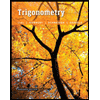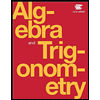The population of a certain inner-city area is estimated to be declining according to the model P(t) = 436,000e-0.0221 where t is the number of years from the present. What does this model predict the population will be in 14 years? Round to the nearest person. %3D Answer Keypad How to enter your answer (opens in new window) Keyboard Shortcuts people
The population of a certain inner-city area is estimated to be declining according to the model P(t) = 436,000e-0.0221 where t is the number of years from the present. What does this model predict the population will be in 14 years? Round to the nearest person. %3D Answer Keypad How to enter your answer (opens in new window) Keyboard Shortcuts people
Trigonometry (11th Edition)
11th Edition
ISBN:9780134217437
Author:Margaret L. Lial, John Hornsby, David I. Schneider, Callie Daniels
Publisher:Margaret L. Lial, John Hornsby, David I. Schneider, Callie Daniels
Chapter1: Trigonometric Functions
Section: Chapter Questions
Problem 1RE:
1. Give the measures of the complement and the supplement of an angle measuring 35°.
Related questions
Question
![**Population Decline Model Analysis**
**Question Context:**
The population of a certain inner-city area is estimated to be declining according to the model:
\[ P(t) = 436,000 e^{-0.022t} \]
where \( t \) is the number of years from the present.
**Task:**
Determine what this model predicts the population will be in 14 years. Round to the nearest person.
**Input:**
There is a textbox provided to enter the answer in terms of 'people.'
**Instructions:**
- Use the given exponential decay model.
- Substitute \( t = 14 \) into the equation to calculate the predicted population.
- Enter the calculated number in the provided textbox.
**Tools:**
There is an option to access a keypad and keyboard shortcuts for easier input.
**Reference:**
© 2021 Hawkes Learning
**Solution Approach:**
- Calculate \( P(14) \) using the formula:
\[ P(14) = 436,000 \times e^{-0.022 \times 14} \]
- Perform the calculations to find the number of people.
- Enter the result in the answer box and submit.
This educational example demonstrates exponential decay in a population context, allowing learners to apply mathematical models to real-world scenarios.](/v2/_next/image?url=https%3A%2F%2Fcontent.bartleby.com%2Fqna-images%2Fquestion%2Ffcc8d613-278a-4e26-bcde-ff270d7bcffc%2F021fa707-5569-484e-8e7a-f25910268f57%2Fm3w5b.jpeg&w=3840&q=75)
Transcribed Image Text:**Population Decline Model Analysis**
**Question Context:**
The population of a certain inner-city area is estimated to be declining according to the model:
\[ P(t) = 436,000 e^{-0.022t} \]
where \( t \) is the number of years from the present.
**Task:**
Determine what this model predicts the population will be in 14 years. Round to the nearest person.
**Input:**
There is a textbox provided to enter the answer in terms of 'people.'
**Instructions:**
- Use the given exponential decay model.
- Substitute \( t = 14 \) into the equation to calculate the predicted population.
- Enter the calculated number in the provided textbox.
**Tools:**
There is an option to access a keypad and keyboard shortcuts for easier input.
**Reference:**
© 2021 Hawkes Learning
**Solution Approach:**
- Calculate \( P(14) \) using the formula:
\[ P(14) = 436,000 \times e^{-0.022 \times 14} \]
- Perform the calculations to find the number of people.
- Enter the result in the answer box and submit.
This educational example demonstrates exponential decay in a population context, allowing learners to apply mathematical models to real-world scenarios.
Expert Solution
This question has been solved!
Explore an expertly crafted, step-by-step solution for a thorough understanding of key concepts.
This is a popular solution!
Trending now
This is a popular solution!
Step by step
Solved in 2 steps

Recommended textbooks for you

Trigonometry (11th Edition)
Trigonometry
ISBN:
9780134217437
Author:
Margaret L. Lial, John Hornsby, David I. Schneider, Callie Daniels
Publisher:
PEARSON

Trigonometry (MindTap Course List)
Trigonometry
ISBN:
9781305652224
Author:
Charles P. McKeague, Mark D. Turner
Publisher:
Cengage Learning


Trigonometry (11th Edition)
Trigonometry
ISBN:
9780134217437
Author:
Margaret L. Lial, John Hornsby, David I. Schneider, Callie Daniels
Publisher:
PEARSON

Trigonometry (MindTap Course List)
Trigonometry
ISBN:
9781305652224
Author:
Charles P. McKeague, Mark D. Turner
Publisher:
Cengage Learning


Trigonometry (MindTap Course List)
Trigonometry
ISBN:
9781337278461
Author:
Ron Larson
Publisher:
Cengage Learning